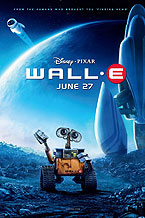35WALL-E (2008)
Screenplay by Andrew Stanton, Jim Reardon, Original Story by Andrew Stanton, Pete Docter

The poetic storyline of WALL-E, Pixar’s love story/cautionary tale about a lonely robot on a futuristic Earth crammed with garbage, didn’t come easily. According to Andrew Stanton, the concept emerged during a lunch with co-writer Pete Docter and Pixar’s then-boss, John Lasseter. Gradually, Stanton and his collaborators generated additional ideas. WALL-E finds love with another robot. Humans, stuck traveling in space for decades, have become shapeless blobs whose primary interaction is with entertainment devices. WALL-E discovers a plant, suggesting a path toward reclaiming Earth from the ravages of unchecked consumerism. Throughout the process, Stanton strove for storytelling purity—which meant keeping dialogue to a minimum. Working with Jim Reardon, who supervised the movie’s storyboard team, Stanton crafted some of the most transcendent moments in the Pixar canon—wordless sequences of diligent little WALL-E going about his work until circumstances draw his curiosity and empathy to the surface.
